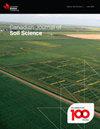土壤团聚体稳定性和不稳定碳对等高线耕作、导流梯田、草地水道和瓦片排水的短期响应
IF 1.5
4区 农林科学
Q4 SOIL SCIENCE
引用次数: 1
摘要
土壤退化一直是新不伦瑞克省马铃薯农民非常关心的问题,特别是在坡地和浅层土壤上。在本研究中,我们评估了土壤活性碳(C)组分(高锰酸盐可氧化C - POXC;两种综合最佳管理实践(BMPIs)的总体稳定性,包括以下单独的实践:导流梯田(DT)、草地水道(GW)和等高线耕作(CT)[即DTGW]和DT、GW、CT和瓦片排水沟(TD)[即DTGW+TD],相对于作为对照的CT。田间调节水量越多,不稳定C的增加越大;其中,DTGW和DTGW+TD分别上涨19.8%和50.6%的POXC,而CT下跌11.2%的POXC。尽管在马铃薯种植期间进行了大量的耕作活动,但梯田bmpi的矿物伴生有机质(MAOM) C却有所增加。两个bmpi对总体稳定性没有影响,很可能是由于最初的监测研究只持续了两个生长季节。尽管土壤结构没有得到改善,但我们的研究结果表明,即使在实施BMPI后的最初两个季节,土壤C也可能得到一定程度的稳定。本文章由计算机程序翻译,如有差异,请以英文原文为准。
Short-term Response of Soil Aggregate Stability and Labile Carbon to Contour Tillage, Diversion Terrace, Grassed Waterway, and Tile Drainage Implementation
Soil degradation has been of great concern for New Brunswick’s potato farmers, especially on sloped land and shallow soils. In this study we evaluated the initial response of labile soil carbon (C) fractions (permanganate oxidizable C – POXC; and particulate organic C – POC) and aggregate stability to two integrated best management practices (BMPIs) comprised of the following individual practices: diversion terraces (DT), grassed waterways (GW), and contour tillage (CT) [i.e., DTGW] and DT, GW, CT, and tile drains (TD) [i.e., DTGW+TD], relative to CT that served as a control. The more water was regulated in the field, the greater the increase in labile C; where DTGW and DTGW+TD gained 19.8% and 50.6% of POXC, respectively, while CT lost 11.2% of POXC. There was an increase in mineral associated organic matter (MAOM) C in the terraced BMPIs, despite the high amount of tillage events that took place during potato cultivation. Two BMPIs had no effect on aggregate stability, most likely due to the short duration of this initial monitoring study that spanned just over two growing seasons. Even though there were no improvements in soil structure, our findings showed that some stabilization of soil C is possible even during the initial two seasons following BMPI implementation.
求助全文
通过发布文献求助,成功后即可免费获取论文全文。
去求助
来源期刊

Canadian Journal of Soil Science
农林科学-土壤科学
CiteScore
2.90
自引率
11.80%
发文量
73
审稿时长
6.0 months
期刊介绍:
The Canadian Journal of Soil Science is an international peer-reviewed journal published in cooperation with the Canadian Society of Soil Science. The journal publishes original research on the use, management, structure and development of soils and draws from the disciplines of soil science, agrometeorology, ecology, agricultural engineering, environmental science, hydrology, forestry, geology, geography and climatology. Research is published in a number of topic sections including: agrometeorology; ecology, biological processes and plant interactions; composition and chemical processes; physical processes and interfaces; genesis, landscape processes and relationships; contamination and environmental stewardship; and management for agricultural, forestry and urban uses.
 求助内容:
求助内容: 应助结果提醒方式:
应助结果提醒方式:


